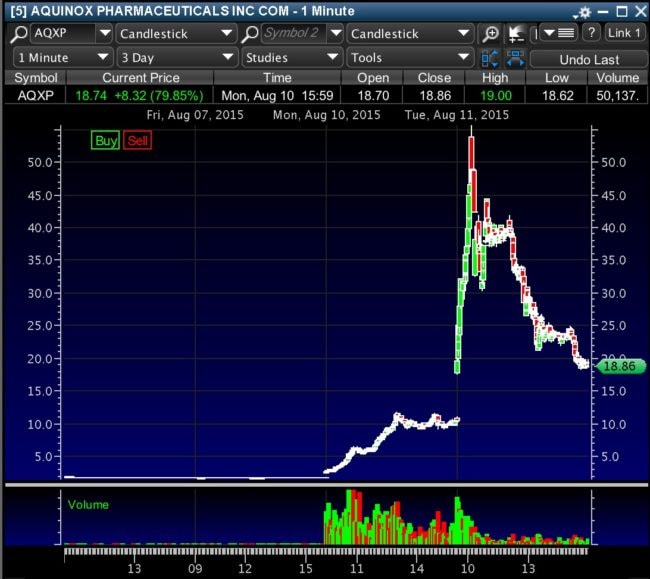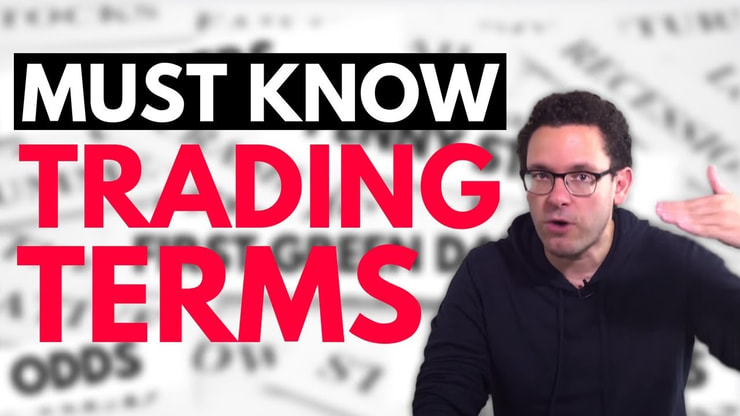Here’s how to play the stock market in 11 steps:
- Risk and Mental Control is a must to play the market
- Choose the right broker for you to play the stock market
- Get to know key stock market terms
- Study stock patterns. They repeat themselves
- Do not use leverage
- Trade volatile stocks to play the market
- Create a stocks watchlist
- Improve your stock market skills with paper trading
- Learn from your mistakes to play the stock market
- Master your analysis skills and learn how to analyze stocks
- Never stop studying and learning about the stock market
This whole trading lifestyle can seem very cool, a little surreal, and overwhelming all at once … especially when you realize how much there is to learn, right?
Even my most successful students started their journeys knowing nothing about trading, then they began learning and everything changed.** Once you start to build knowledge it opens your eyes to the world of possibilities.
Let’s get started with some stock market basics.
The stock market refers to a secondary market where buyers and sellers come together to deal in company shares. In a secondary market, you don’t buy shares from the company. Instead, you buy from an existing owner of the stock.
A stock exchange is the basic trading facility or platform. In the case of the NYSE, traders still execute trades on the trading floor. The Nasdaq is different in that it’s an electronic exchange. But in both cases, the exchange is used to buy or sell company stocks and bonds.
Traders and investors buy and sell stocks listed on the exchange. Stockbrokers make this possible by executing trade orders.
Now you know what the stock market is … but what about investing in the stock market?
Some people contact me and throw that ‘playing the market’ phrase around like this is a big game. I suppose you could look at it that way, but prepare to lose your ass if you don’t take this ‘game’ seriously.
Others send tweets or emails oozing with apprehension and fear. They seem outright scared to play.
Here’s the thing: Whether you’re on the side of fear or you think it’s all a game … it’s all about perspective.
The point I’m trying to make is this: You can learn to trade as long as you start at the beginning with stock market basics and build a base of knowledge . It’s exactly what I did back in the day. And it’s what all my successful students like Mason Fecht (Have you heard about this guy yet? He’s crushing it!), Tim Grittani, and others did.
Now it’s your turn. Let’s dive in …
Table of Contents
- 1 What Are The Stock Market Basics?
- 2 How To Play the Stock Market in 11 Steps
- 2.1 #1 Risk and Mental Control Is a Must
- 2.2 #2 Choose the Right Broker for You
- 2.3 #3 Get to Know Key Stock Market Terms
- 2.4 #4 Stock Patterns Repeat Themselves
- 2.5 #5 Do Not Use Leverage
- 2.6 #6 Trade Volatile Stocks
- 2.7 #7 Create a Watchlist
- 2.8 #8 Paper Trading
- 2.9 #9 Learn From Your Mistakes
- 2.10 #10 Master Your Analysis Skills
- 2.11 #11 Never Stop Learning
- 3 The Bottom Line
What Are The Stock Market Basics?
First things first. You have to understand stock market basics concepts. Without foundational knowledge, you’re toast.
When you buy shares of stock you’re buying into the company. In other words, at some point, the company decides to raise capital to invest in company growth. It may be for research and development, marketing, or even machinery, but the capital is meant to bring return on the investment.
To raise the capital, the company creates shares and sells them in an initial public offering. Then those shares are traded on the ‘stock market.’ It could be the Nasdaq, the NYSE or the OTCBB (which is considered ‘off exchange’).
So, for example: Company X sells shares … shares are available to buy or sell on an exchange.
Next, you need a stockbroker. Your broker executes your trades. When you instruct them to buy, they’ll buy at the best price available depending on your instructions. Brokers must meet certain professional standards set by the Financial Services Regulatory Authority (FINRA).
What else do you need? A brokerage account. Your broker will help you create one. Or, if you use an online brokerage and trading platform, you create it, then transfer money into it, and then you’re off.
But hold on. There are some other things you need to know right away …
Say you put in an order to buy shares. That’s called a bid. Somebody else owns the stock already. They may be asking for a specific price. That’s called the ask. A buyer makes a bid; the seller asks for a price.
The gap between ask and bid is the spread. The bigger the spread, the lower the number of shares that will trade. The closer the spread, the easier it is to buy and sell … because there are sellers and there are buyers and they aren’t too far apart. Cool so far?
Who Can Be a Stock Investor?
It used to be difficult for the average person to be a stock trader. Today, anyone with a computer, high-speed internet connection, a brokerage account, and a trading platform can do it.
But before you dive into getting a bunch of slick trading gear, let’s talk about getting yourself prepared first.
Importance of Being Prepared for Stock Market Challenges
There’s this famous quote by Abraham Lincoln. It goes like this: “Give me six hours to chop down a tree and I will spend the first four sharpening the axe.”
You need to be prepared for challenges when you start trading. There are up days and down days. You’ll have wins and losses; sometimes both on the same day. You’ll likely learn some hard lessons.
The best way to ease into a trading career with less pain? Preparation. Like Lincoln said, sharpen your axe. Study, learn, practice. Apply for my Trading Challenge if you want to be part of a community of traders learning and growing every day.
Now I’ll share 11 steps that are key to gaining a stock market basics education. Some other teachers won’t tell you some of these things (at least not until you’ve paid them big bucks for their latest course), but I’m going to tell you up front because I want you to start preparing right away — today.
How To Play the Stock Market in 11 Steps

#1 Risk and Mental Control Is a Must
This is so important that it has to be number one. Without knowing your risk tolerance and without knowing how to exercise mental control, you could lose big time.
You could do everything else right and at the last second cross your risk boundary and have it all go down the tube!
Let’s start with risk. In any stock market play, the risk-to-reward ratio is the level of risk you’re willing to take, compared to the possible rewards. I teach students to set a risk level before they enter a trade. I show you how to determine that level in my free Trader Checklist course.
Once you set your level of risk, you have to maintain mental control. If you set a target and the trade is going well, once the target is met, close your position. Why? Because this is exercising mental discipline.
The same goes for trades gone wrong. Once you hit your loss limit, close your position. Don’t hope the trade will turn back around!
A great way to keep track of risk and mental control is by using a trading journal. You seriously need to do this. I show you how in this trading journal guide post.
#2 Choose the Right Broker for You
The broker you choose has a lot to do with your investing or trading strategy. Other things to consider are fees and commissions.
There are a ton of brokers out there. As a trader, I look for brokers to meet very specific needs. Over the years I’ve been through dozens of brokers. I’ve pretty much tried them all.
Different brokers have different rules and different minimums. Depending on where you live there might be different rules as well. Say you’re learning how to trade the stock market in India. Well, the brokers and stock market basics rules there might be different.
Check out this post about choosing an online broker to get an idea of some of the possibilities and learn about the brokers I use.
#3 Get to Know Key Stock Market Terms
Bull market, bear market, earnings releases, dividends, volatility … the list goes waaaay on.
The stock market has its own language. You must know key stock market basics terms. Here’s a short ‘scratch the surface’ list of definitions to start with now. For a more in-depth list, check out 37 stock market terms that every trader should know to succeed.
Learn them. Study them. Every day. You’ve gotta know this lingo like the back of your hand.
Bear market: When major indexes drop 20% or more from recent highs, it’s a sign of a bear market
Breakdown: When a stock breaks below the previous lows. This could be daily, weekly or even 52-week levels. Breakdowns tend to keep going lower because, theoretically, there’s bad news about the stock.
Breakout: A breakout happens when a stock breaks above previous highs. Again, this could apply to daily, weekly, monthly, or 52-week levels. Breakouts tend to keep going higher for the same reason breakdowns tend to keep going lower: news.
Bull market: When major indexes rise 20% or more from recent lows, it’s a sign of a bull market. We’ve been in one of the longest bull markets in history recently. Some pundits think it’s about to end. We’ll see.
Market correction: When the major indexes drop 10% from recent highs, it’s a correction. It’s often considered positive because it gives time for a period of consolidation and prepares the market for the next advance.
Quarterly earnings release: This is important for both traders and long-term investors. When a company releases its quarterly revenue and earnings per share you can tell how the company is doing. Earnings can be a strong catalyst for big price jumps. As a trader, that’s highly valuable information.
Dividends: Some companies pay dividends to shareholders. Others invest profits back into the company. This creates two categories of stock: dividend stocks and growth stocks. More established companies sometimes pay their shareholders dividends on a regular basis.
Bid-Ask Spread: As I explained earlier, ask is the price a seller wants for their shares. Bid is the price a buyer is willing to pay. The spread is the difference.
Short: You know the phrase ‘don’t sell yourself short’? Well, that doesn’t necessarily apply to penny stocks. Short selling is my all-time favorite trading strategy. Going short means you bet on a stock going lower.
Long: Going long means you bet on the stock price going higher. Breakouts tend to keep going higher because, theoretically, there is good news.
Trading platform: Technically, this isn’t a ‘stock market’ term. I included it because without a trading platform you can’t trade. I use — and recommend — StocksToTrade. I was part of the development team. We created it because we wanted a platform that does everything you need it to do all in one place. It seriously kicks ass.
Volatility: I’ll get more into this in step #6. Volatility is the difference in price between a low and a high for a stock within a given period (usually a day). In other words, it’s the amount of price swing. I like volatility. It allows me to look for certain set-ups and patterns I know can be profitable.
#4 Stock Patterns Repeat Themselves

One of the things I learned early in my stock trading career is this: Patterns repeat themselves in the stock market. Patterns that were happening 20 years ago are still happening!
Sometimes things shift based on market sentiment and the economy, so you’ll have to adapt your style to the types of trades available. But you keep the knowledge of what you’ve been doing because it will likely come back at some point.
An example of this is my experience back in 2000. I had been trading for around two years when suddenly the type of trades I was playing stopped. The tech bubble was about to burst and the setups I was using simply weren’t appearing.
What did I do? Did I try to force trades? Hell no! I took a step back and started studying again so I could figure out a new strategy. I looked for new patterns. It’s all chronicled here in my free book: “An American Hedge Fund.”
I teach my Trading Challenge students all of the patterns I use. You can also find a lot of information about patterns on my YouTube channel.
You don’t have to learn them all at once. As a matter of fact, I recommend you only use a few at first.
#5 Do Not Use Leverage
This is extremely important: Do not use leverage.
As soon as you open a trading account your broker will ask you if you want a margin account. Unless you really, really know what you’re doing and need a margin account for short selling, say no!
Trading with leverage means you make trades with borrowed money. Start with $25K … borrow another $25K … and you have $50K to trade with. Sounds exciting, right?
But what if you make a trade and lose $40K right out of the gate? That’s right, your broker will call you and ask for enough money to cover your margin. It’s called a margin call (another term to know). That means you have to come up with another $15K just to break even. Ouch.
And it only gets worse as your account grows. Don’t do it.
Instead, learn to trade the right way. Learn to mitigate risk and cut losses quickly. Learn all the ideas I’ve been trying to teach you for however long you’ve been reading my posts, watching my videos, and learning my strategies.
#6 Trade Volatile Stocks
I touched on volatility a little already. I love volatility. It means there are buyers and sellers and prices are going up and down. The reason I love trading penny stocks is because of the extreme volatility combined with big percentage moves!
In other words, if a stock is trading for such a low price, say $1 per share, then a 20 cent move is 20%. That’s huge. You aren’t likely to find that even in most small-cap stocks, and certainly not in large-caps.
Volatility might seem a little scary at first, but learn to embrace it. One way to learn about the volatility of a particular stock is to …
#7 Create a Watchlist
I recently wrote a post about how to create a watchlist. Whether you want to trade or you’re a long-term value investor, you should always have a watchlist.
You need to do your homework about the stocks you want to buy. Period. Would you go buy a television or smartphone without learning something about it? Some people do. But I wouldn’t.
So create a watchlist. I’ll even give you my own watchlist every Sunday! That can help you get started.
#8 Paper Trading
When you paper trade, you make imaginary trades and the software treats it as if it were a real trade. Your account goes up and down just as it would in real trading — but you’re using fake money.
Paper trading is awesome and I hope you do it (StocksToTrade offers paper trading). Use your paper trading time to learn your set-ups and burn the knowledge into your brain.
Remember what Lincoln said: Sharpen your axe.
#9 Learn From Your Mistakes
Learning from your mistakes is key to success in any area of life, right? When it comes to trading it can mean the difference between rich and an empty account. If you make a trade and it goes wrong, don’t just forget about it and carry on!
Instead, examine the setup, look again at the news, see if you had the right entry point and exit point. In other words, use it as a tool for learning.
I can’t use the phrase ‘get rich quick’ or my lawyer’s head will spin around all Exorcist-style. So I’ll say this instead: If you want the key to getting ahead in this game, learn from your mistakes.
#10 Master Your Analysis Skills

One of the basics of investing in the stock market is to understand how to analyze stocks.
You have to be able to look at a chart and see what’s going on. You need to know why things are moving — or at least have an educated guess.
There are two main types of analysis. Which you prefer depends a lot on your strategy. But you should learn both if you’re serious about trading or investing.
Technical Analysis
Technical analysis is all about reading stock charts and using key indicators. You’ll learn about things like moving averages, support and resistance, and pivot points.
For most patterns I trade I don’t use more than a few key indicators combined with identifying a catalyst. A catalyst might be something like a press release or earnings announcement.
Fundamental Analysis
Fundamental analysis is more concerned with the underlying fundamentals of the company.
- What is their revenue?
- What’s their earnings projection?
- How much debt do they have?
- What is their growth projection?
These things can affect stock price. Long-term value investors usually focus on fundamentals. I focus more on the technical side.
#11 Never Stop Learning
As you can see, there’s a lot to learn — and I’ve barely scratched the surface.
I suggest you go through each of these 11 steps and see what you can do today. Start a watchlist. Begin to identify your risk tolerance. Search for information on stock analysis. Get a notebook and start keeping track of what you learn.
Consider this deep work. Set aside time each day to focus on learning. No distractions. Step away from social media, the television, your phone. Take notes. Keep building knowledge.
You might be amazed at how fast some of this starts to make sense. You’ll also discover where your knowledge gaps are.
The Bottom Line
I hope this helps you start today, right now, to create the stock market basics habits that all my top students have.
I also hope you understand you have your work cut out for you. You can’t cheat success.
With that in mind, why not apply for my Trading Challenge? It’s a complete immersion in everything you’ve just read and far more.
Are you a trader? Or do you want to be a trader and this is all brand new to you? Comment below. I want to hear from you!






Leave a reply